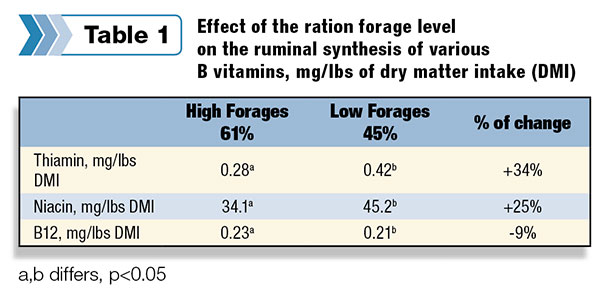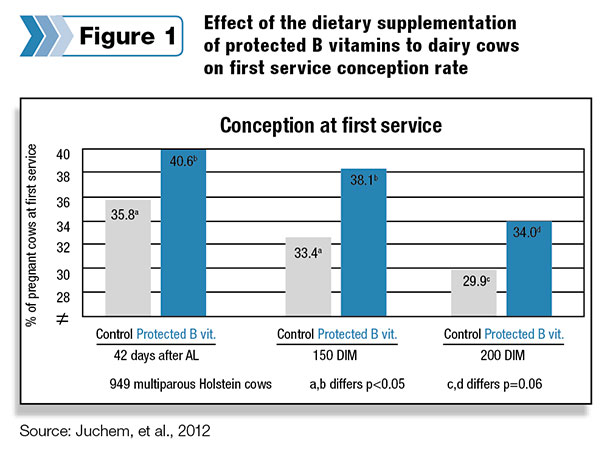As either a dairy producer or a nutritionist, your goal is to keep the ration composition constant to maintain the rumen environment for better dairy cow health and performance. The reality on most farms makes it difficult to achieve; forage quality varies from one harvest to the next, as well as ingredient sourcing and change in prices. Some factors may not be readily known, or change during the course of the feeding season, such as starch digestibility in silage or fiber digestibility throughout the pile.
It is well-known that any ration changes will influence the rumen environment and its microbial population. Ingredients will be degraded and utilized differently in the rumen and will provide a completely different nutrient profile to the cow. The rumen solubility of amino acids, fat and carbohydrates will vary, and ration formulation will need to be adjusted.
Often overlooked, the amounts of B vitamins available to the cow change with the ingredient composition of the ration as well as rumen fermentation events. In fact, B vitamin synthesis by rumen microbes is greatly modified with such changes.
Although we are still at the early stage of understanding the influence of ration composition on the rumen synthesis and degradation of B vitamins, researchers are showing a causal relationship.
The influence of forage-to-concentrate ratio was studied in a few experiments. Rumen microbial synthesis of riboflavin (B2) increased while B12 synthesis decreased when the ration was composed of only 40 percent forages compared to a higher forage-to-concentrate ratio (60-40).
In a more recent study, the same pattern was observed for the microbial synthesis of B12 with low forage-to-concentrate ratio. These scientists also measured the ruminal synthesis of other B vitamins, like thiamin and niacin, and observed an increased synthesis when the forage concentration in the diet was reduced from 61 percent to 45 percent.
Ruminal apparent synthesis was calculated by the B vitamin duodenal flow (reaching the intestine) minus dairy cow B vitamin intake (Table 1).

The type of forage will also influence the ruminal synthesis of many B vitamins, probably through its effect on rumen pH and microbial nitrogen. A ration composed of orchardgrass instead of alfalfa haylage had a higher ruminal synthesis of thiamin, riboflavin, niacin and pyridoxine. In this same study, they showed that the type of corn processing will likewise influence B vitamins’ ruminal synthesis.
Other factors are known to affect B vitamin synthesis, such as precursors for vitamin synthesis, anti-nutritional factors and microbial growth rates, but have not been fully quantified. We can confirm that ration composition will affect the extent of the synthesis of various B vitamins by rumen microbes.
We also know, from previous studies, that unprotected B vitamins provided in the ration are degraded by rumen microbes to different levels with some B vitamins, like folic acid, being degraded at 97 percent.
Should we supplement B vitamins to dairy cows to overcome the variation in ruminal synthesis and to meet the requirement of the dairy cow?
Studies conducted since 1995 show improvements in milk production, milk component yield, feed efficiency, health status around parturition and reproduction when dairy cows were supplemented with B vitamins in a form to escape the rumen, either injected directly or protected from rumen degradation.
A more recent study, conducted at University of California – Davis, evaluated the effect of supplementing in the diet a blend of protected B vitamins (folic acid, B12, pyridoxine, pantothenic acid and biotin) on reproductive performance.
The study involved 949 multiparous dairy cows split into control and treatment groups. Data was collected for more than one year in this side-by-side study. During that long period, the forage source and some ingredients changed. Both groups had access to the same ration that was changing over time, due to the way the experiment was designed.
The supplementation of the protected B vitamins blend improved first-service conception rate by 13 percent over the control group. This improvement was maintained until 200 days in milk (Figure 1).

The researchers suggested that ruminal synthesis of B vitamins was not sufficient to meet the requirement of the dairy cow for optimum reproductive performance.
We are still very far from predicting B vitamins’ quantities available for the cow based on ration composition and formulating ration accordingly to meet B vitamin requirements.
Many studies have demonstrated the benefit of supplementing a protected B vitamin blend to dairy cows to improve performance and health, suggesting that B vitamin ruminal synthesis is not sufficient to achieve optimum performance on many occasions.
References omitted due to space but are available upon request. Click here to email an editor.






